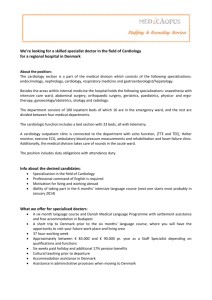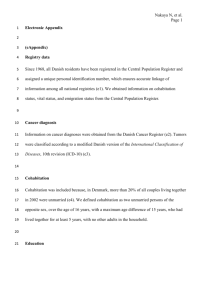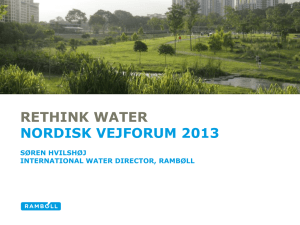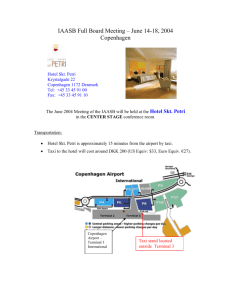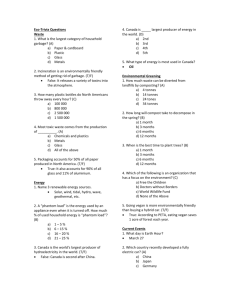Denmark_2015 - Epiet Alumni Network
advertisement
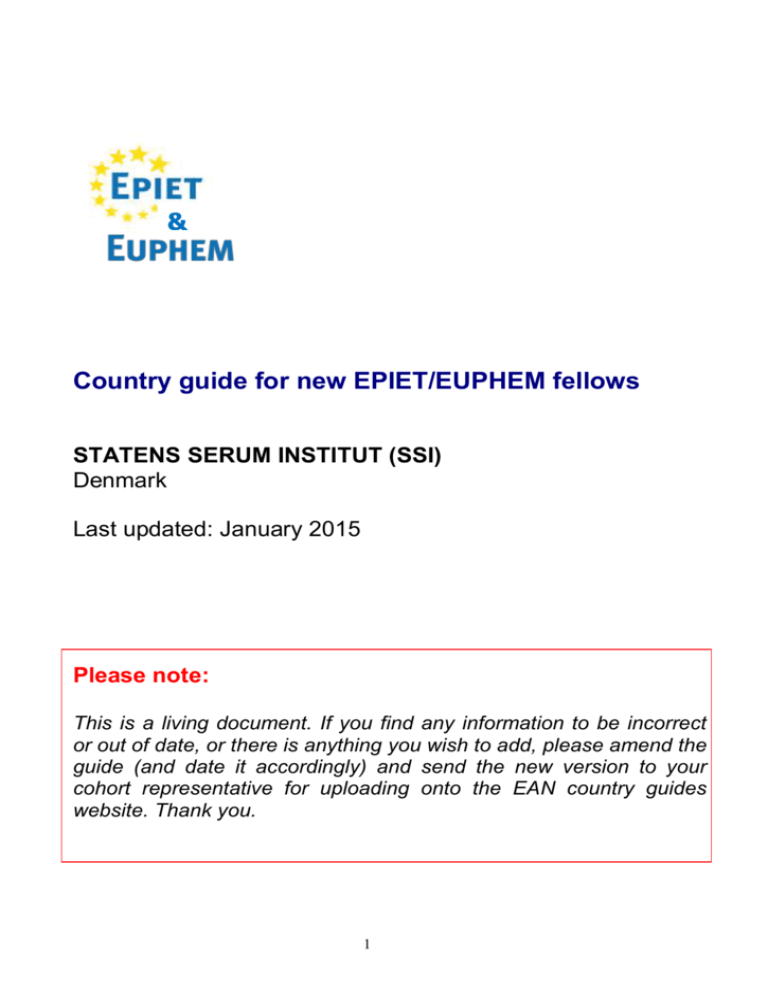
& Country guide for new EPIET/EUPHEM fellows STATENS SERUM INSTITUT (SSI) Denmark Last updated: January 2015 Please note: This is a living document. If you find any information to be incorrect or out of date, or there is anything you wish to add, please amend the guide (and date it accordingly) and send the new version to your cohort representative for uploading onto the EAN country guides website. Thank you. 1 EPIET/EUPHEM Country Guide to Denmark Created by Maike Koningstein, PhD student 2006-2011 Hannah Lewis, EPIET fellow 2006-2008 Updated by Sabrina Bacci, EPIET fellow 2007-2009 Katarina Widgren, EPIET fellow 2008-2010 Sophie Gubbels, EPIET fellow 2009-2011 Oktawia Wójcik, EPIET fellow 2010-2012 Frederique Dorleans, EPIET fellow 2011-2013 Lieke Van Alphen, EUPHEM fellow 2011-2013 Julita Gil Cuesta, EPIET fellow 2012-2014 Annika Wendland, EPIET fellow 2013-2015 Silvia Funke, EPIET fellow 2014-2016 Last updated: January 2015 2 1. Before departure 4 1.1. Visa 2. Registration in Denmark 5 2.1 Residence permit (and working permit) 2.2 Registration process for nationals from countries in the EU and EEA 2.3 Registration process for Nordic Citizens 2.4 Registering with the Embassy from your home country 3. Living in Denmark 7 3.1 Housing 3.2 Transportation 3.3 Money, credit cards, banks and pension 3.4 Insurances 3.5 Telephone 3.6 Internet 3.7 Language courses 3.8 Furniture and household goods 3.9 Supermarkets 3.10 Sport 3.11 Useful websites A few last useful points 14 3 1 Before departure The majority of things can be done on arrival. The department will give you plenty of time to sort all these things out during working hours and colleagues will be there to help. Although Danes speak perfect English, many of their websites do not have an English version. However, you can use Google Chrome to automatically translate the websites, or use www.google.com/translate. It will not be perfect, but at least it will give you an idea of what the website says. What can be done before you leave? This depends on the country you are a national of (Nordic country, EU country or a non-EU country). Check this website before you leave: http://www.nyidanmark.dk/en-us/frontpage.htm 1.1 Visa Whether you need a visa or not depends on the country you come from as well. EU citizens do not need a visa. People from other countries do need a visa. If you are from one of the new member states of the EU, please check whether some new rules apply for you. This information can be obtained from your embassy. 1.2 Removal For fellows starting from 2013, claims for removal expenses are going through SSI: This means that you will need to contact the Infectious Diseases Epidemiology department (your supervisor) regarding your removal. SSI, once they approve the removal company, may directly pay for the removal and will get reimbursed from ECDC. Please discuss the details with your supervisor as soon as possible. 1.3 Finances At the beginning of the fellowship you will have a lot of expenses (flight tickets, removal, health insurance, deposit for renting a flat, etc). It is wise to have a couple of thousand euros in your bank account at the start of the fellowship to help with cash flow (maybe even up to 5,000€) Please note that it is not uncommon in Denmark to ask for 3 months of rent as a deposit PLUS 3 months’ rent in advance, which can amount to quite a substantial sum of money. 4 2 Registration in Denmark 2.1 Residence permit (and working permit) Depending on your citizenship: Citizens of the Nordic countries may enter and work in Denmark without any permit for an unlimited period Nationals from countries in the EU and EEA (Norway, Lichtenstein and Iceland) as well as Switzerland may enter and work in Denmark without permits for up to three months but must then obtain them. NB. Special transitional rules apply to eight of the new EU countries. Non-EU nationals must acquire both a residence and a work permit prior to arrival in Denmark. If you have more questions check this website: http://www.workindenmark.dk 2.2 Registration process for nationals from countries in the EU and EEA After arrival in Denmark you must contact a number of Danish authorities. Since 2013, all these administrative bodies have come together at the ‘International House’, where you can organise all the following required documents: an EU registration certificate a social security number (CPR number) a medical card (yellow card) a tax card (this is not necessarily a physical card) In order to get any of the above, you need an employment contract or a letter of intent, which you will get from the personnel department at SSI. If possible, try to get a contract before the day you start and make sure that the details are correct as per the ECDC director’s decision. It is possible to have all your paperwork done in one place at International House (EU registration, CPR number, medical card, SKAT (tax)). Note: to be able to do any of these, you must have an address that is valid for at least 1 month and you have to show a rental agreement for this (even if it is a receipt for a hotel or temporary apartment – it can even be handwritten as long as it is signed by the landlord). The experience at International House was very positive, and all the documents were received on the spot, as long as all the required items (passport, photo, filled in registration form, employment contract, rental agreement, marriage certificate/children’s birth certificates if applicable, etc) were brought on the first visit. Some staff members there may be more flexible than others. International House: http://subsite.kk.dk/sitecore/content/Subsites/InternationalHouseCopenhagen/SubsiteFr ontpage.aspx (or google ‘International House Copenhagen’) Gyldenløvesgade 11, 1600 Copenhagen V, +45 33661000 The lounge is open Mon-Wed: 10.00-15.00 Thurs: 11.00-15.00 Fri: 10.00-14.00 5 Please note that the International House was a new addition in 2013. If you are unable to obtain your documentation through them, please have a look at previous versions of this document in ‘EPIET’folder on the department’s drive, once you arrive at SSI. You then wait for a letter in the post with contains your EU registration certificate entitled “Bevis for Registrering”. Note that the Certificate will be sent to the address you provide and it might take up to six weeks, since there are many students applying at the same time (in 2013, this took only 1 week). You will also receive your yellow health care card in the mail: Once registered, you will automatically join the National Health Service. The health insurance certificate (sygesikringsskort) gives you access to free medical treatment and other public services. At the international house you choose a general practitioner (GP) from a list according to where you live. You have the choice to pick a GP of the same sex or even choose the GPs by year of birth. You can apply for your tax card at the International House too. The tax card shows your percentage of taxation and your tax allowance (in Danish: skattemæssigt fradrag). If you do not have a tax card, SSI will have to withhold 60% of your salary for taxes. See www.skat.dk for more information. Note: In 2013, fellows did not obtain their tax cards at the international house for the following reason: If you are employed as a researcher or otherwise can be defined as a key employee and are recruited from abroad, you may opt for 26% taxation for 5 years (+ a compulsory 8% tax that is applied before the 26% - a bit complicated, but what this means is that in the end you pay 31% tax on your salary). You can read more about the application process at http://www.skat.dk/SKAT.aspx?oId=97319&vId=202341 . The secretary in your department at SSI can help you apply for this taxation scheme and in such cases will have to make a statement for the local tax authorities on your qualifications and background for being recruited as a key employee. Because the statements were not ready at the time we went to the international house, we applied for the tax card separately, which meant we got taxed 60% in the first month, but were automatically reimbursed once the application had gone through. A guide to your monthly payslip: See appendix, it may help you understand the taxes and your contract. Please send the following to the personnel department at SSI as soon as possible: 1) 2) 3) 4) Your address in Denmark Social security number (CPR) Your Danish bank account (see 3.3) If relevant, confirmation on the special researcher taxation 2.3 Registration process for Nordic Citizens If you come from another Nordic country this process is a little easier. You should visit your closest Borgerservice office to register (bring your Nordic passport). You may also be able to go through International House (see 2.2): http://www.kk.dk/Borger/Borgerservice/Borgerservicecentre.aspx In order to get a CPR-number you have to show proof that you have a job and are paying taxes in Denmark (which may or may not be applicable to EPIET-fellows) and/or a proof of residence in Denmark, such as a contract to rent a flat. 6 2.4 Registering with the Embassy from your home country Some countries require that you register at the Consulate/ Embassy in Denmark as a citizen residing abroad. For Italian citizens, you are theoretically required to register at the Consular section of the embassy in Copenhagen within 90 days of your arrival in Denmark. Such registration, will also allow voting for political elections at the embassy. For more info on Italy, please see: http://www.ambcopenaghen.esteri.it/Ambasciata_Copenaghen/Menu/Informazioni_e_servizi/S ervizi_consolari/Anagrafe http://www.emigrati.it/Emigrazione/Anagrafe_I_Residenti_Estero.asp 3 Living in Denmark 3.1 Housing To find a place to live can be quite hard. There are two youth hostels very close to the Institute, one called Danhostel Amager, http://danhostelcopenhagen.dk/en/ (Vejlands Allé 200, 2300 Copenhagen S, +45 3252 2908) and one called Danhostel Copenhagen City, http://www.danhostel.dk/hostel/danhostel-copenhagen-city (H.C. Andersens Boulevard 50, 1553 Copenhagen V, +45 3311 8585). Another option to stay while looking for permanent accommodation is airbnb (www.airbnb.com). You can choose from a variety of rooms and apartments rented out from local hosts. Renting in Denmark Prepare for prices of 3000 Kr minimum for a shared apartment. To rent your own flat will cost something between 6,000 - 10,000 Kr+ per month. If you want to live in the inner Copenhagen area (postcodes up to 2300), prepare to pay something in the higher range (in 2013, it was challenging to find anything <9000Kr). Know what is included in your rent because there are additional charges for: - Electricity - Gas - Heating (separate as it comes direct from the Kommune) - Water - TV, Internet Please note: - It is possible to sublet a partially, or fully furnished apartment if that is what you want. - It is very common to ask three months worth of rent in deposit!! - It is also very common to ask for three months rent in advance!! - There is no definite first come, first serve policy. Landlords like to meet their prospective tenants and then make a choice. However, they have so many potential tenants to choose from that it is advisable to contact them as soon as you see something that you like (it could be gone the same evening during peak times). There are many websites where you might be able to find housing. Be aware that you often have to pay a fee. 7 Websites only in Danish: http://www.dba.dk (the free “Den blå avis” Copenhagen newspaper, is cheapest option) http://www.lejebolig.org http://boligbasen.dk (please note that most places don’t have photos, even if you pay) http://www.findbolig.nu http://www.ledige-lejligheder.dk (had a scam ad in it before) Websites which are also available in English: http://www.boligportal.dk http://www.housingdenmark.com http://en.copenhagenhomes.dk http://www.homesandhousing.dk/eng http://www.housingcompany.dk http://www.danishhomes.com http://www.cphbolig.dk http://www.cityapartment.dk http://www.expresshousing.dk http://www.apartmentincopenhagen.com http://www.copenhagenhousing.com http://www.shbolig.dk In Denmark, it is the owner who pays real estate agent fees not the person looking for an apartment, so it can’t hurt to look at places using professional sites/companies. Be careful not to get scammed, when you look for an apartment without an agent! There are people renting out flats that don’t exist. The typical story is that the apartment seems too good to be true (too big for the price). The owner often tells you that he is in the UK (or abroad) and is using a phone number starting with +44 70. This is a number that is used from another country and directed through the UK. The owner typically tells you to pay a deposit before you’ve seen the apartment, ‘so that he knows you are serious about renting the apartment’ or needs you to make a deposit to send you the keys by mail since he/she is living abroad. Often the owner also wants to know your personal details like passport number etc. The story can sound very realistic and may include a (non-existing) rental agency. Therefore, never pay anything before you´ve seen the apartment. 3.2 Transportation Bicycling Bicycling is big in Denmark, especially in the summer. Bicycles can be bought new in bicycle stores that can be found everywhere in the city. However, they don’t come cheap. Most new bikes cost between 2000 and 3000 DKK+ (sales in January and July-August may be the best time to buy). The cheapest option for new bikes are the big supermarkets as Kvickly, Føtex, etc., or a car and motor bike shop called, T. Hansen (cheapest bikes start at 1300-1400 DKK). Second-hand bikes also don’t come cheap, so be aware! They can be advertised in: www.dba.dk and many bike shops also have second hand bikes, particularly in Nørrebro. Second hand bikes start from around 800DKK. Second-hand bikes are also sold in different Facebook groups for Copenhagen. 8 Become familiar with the bicycling rules because they might be different from what you are used to in your home country, especially at crossings. And fines are often given by the police. You are required to have lights on your bicycle from sunset to sunrise. A set of bicycle lights can be bought in most supermarkets. Public transport You can choose between buses, S-togs (trains) and the metro. How to travel from point A to point B and on-line maps can be found at: http://www.rejseplanen.dk/ (just click on the English flag for the English version); they also have a great mobile app. You may also want to purchase a Copenhagen A-Z map which can be obtained from petrol stations. Buying tickets: - The city is divided in zones, and the fare you have to pay depends on the number of zones you are travelling through. You pay for a minimum of two and a maximum of seven zones. You will always need two zones even if you are traveling in the same zone. - Tickets can be purchased from machines at the metro or train stations and on the bus from the driver. Please note that you should bring coins if you plan to buy tickets from the bus driver. The machines at the stations will accept coins as well as credit cards. - A regular ticket is a single trip ticket. The 2 and 3 zone tickets are valid for one hour and can be used in the metro, bus, train and harbor bus. - You can also buy a ‘Rejsekort’ www.rejsekort.dk which you use to check in at the blue points when you get on and scan again to check out when you get off (note that there are always 2 blue points and you have to use the right ones: ‘ind’ to check in and and ‘ud’ to check out). The Rejsekort has to be charged with money and then the appropriate amount is deducted when you check out. You will pay a penalty if you do not check out. You can buy it at machines and major transport hubs and probably elsewhere too. Note: travelling with a rejsekort is much cheaper than buying individual tickets every time. - Another option is the “periodekort”, (unlimited travels in the zones you choose) valid from a minimum of 30 days up to 365 days. You do not need to buy according to months, but you choose according to days. For the 65 days card you need a picture. More information about the different kinds of tickets: http://www.visitcopenhagen.com/copenhagen/transportation/tickets-prices Getting to the SSI: You can easily reach the SSI by public transport. - You can take the metro to Islands Brygge (Vestamager direction if you come from the North, the city centre for instance. Or else change at Christianshavn for the right line). From there it is about 5 minutes walk to SSI. - Bus 5A stops in front of SSI. 3.3 Money, credit cards, banks and pension The currency in Denmark is (Danish) kroner (crowns), abbreviated as kr. or, internationally DKK. 100 kr is approximately 14 euros. Most credit cards are accepted in Denmark although you pay an additional 9 fee. There are however some stores which only accept Danish cards with the DK logo (Dankort). Cash dispensers can be found everywhere, and bank cards, including the ones with a Maestro logo, work in these machines. Opening a bank account To open a bank account you need to present your CPR number and documentation for your address in Denmark to any Danish bank. However, as getting a CPR number can take a few weeks (note: fellows in 2013 got it on the day they applied for it at International House), there is a slight possibility that the main banks (Danske Bank, Nordea etc.) may be able to open an account for you based on your home address. If you open more than one bank account, you must select one of the accounts as your “nemkonto” (which is the official account where tax, municipality and other state matters will be referred to. You will receive information about this in the mail). Some banks will not give you a Dankort (Danish bank card) until they have seen that a regular income comes into the account for 3 months. You may apply for the Dankort after 3 months. In the meantime, you will be allowed to have a Danish Credit Card, which may also be used to withdraw cash and pay in larger shops/supermarkets. Smaller shops only accept cash or Dankort. Most banks in Denmark are closed on Saturdays and Sundays, but may be open longer on Thursdays. (It is fairly common to swipe out (take a break) when you’re at the office to do your banking). Note: Try to open your bank account as soon as possible and forward the bank details to SSI in order to receive your paycheck in a timely fashion. 3.4 Insurances Public health insurance Everyone residing in Denmark has the right to health insurance services as well as hospital assistance. The services included in the public health insurance are free medical consultation from a general practitioner and medical consultation from specialists with a referral from a GP. Services also include subsidies for medications, dentist and chiropractor consultations - with a referral from your general practitioner - physiotherapy, podiatry and psychology consultations. The subsidies vary according to type of treatment and will be subtracted from your bill. However, be aware that dentist treatments and consultations are mainly supported by the patients’ own expenses. When contacting GP, dentist etc. you will have to present your “sygesikringskort” as proof of your right to health care insurance. Note that it might take a while to get your CPR number, and thus to be enrolled in the Danish health insurance. With the exception of emergency hospital assistance, you must pay for any treatment you need during the first weeks in Denmark. Emigrating from your own country may make you not eligible for the (public or private) health insurance in that country anymore. You might want to consider a private insurance (e.g. specifically for expats) to cover for the meantime. Other insurances The ECDC recommends that you obtain additional insurance including: travel, disability, work liability, etc. Many of the former EPIET Fellows have recommended ExpatPlus. (https://www.expatplus.com/English/international-healthcare-medical-insurance-for-expats.htm). 10 If you would like to get the additional insurance from a Danish provider, you will need your CPR number. Codan (www.codan.dk) and Tryg (www.tryg.dk) are the two largest and most popular firms. The websites are in Danish however, you can call them for any inquiries and they do have policy papers in English. 3.5 Telephone Again, a CPR number is of crucial importance for any phone with a contract. If you do not want to wait until you get your CPR number we recommend that you get a pay-as-you-go SIM card first. These can be obtained virtually everywhere - from petrol/gas stations, 7/11’s, supermarkets and in kiosks. There are many providers – check the newspaper, ask your colleagues for help and any offers. Cheap option is Telmore (www.telmore.dk) and CBB (www.cbb.dk). Lebara has cheap SIM cards (www.lebara.dk), where the fees are specifically cheap for phone calls abroad. Lyca mobile provides good opportunities to call for free under certain conditions (www.lycamobile.dk). 3 (www.3.dk) offers good options for going online abroad. If you need a land line phone, there is no need anymore to go through the process of having a land line phone installed by a company, you can have an online number with Skype and it takes only a few minutes to get one: http://www.skype.com/intl/en/features/allfeatures/online-number?intcmp=so-offer2r1-50offOnlineNumber. You may want to give very cheap phone calls to a specific country of your choice as well. Again Skype offers some good opportunities to do so with Skype Premium: http://www.skype.com/intl/en/prices/premium/?intcmp=so-offer3-r2-premiumTelco. 3.6 Internet There are many providers (Fullrate, Skyline, etc.) – check the newspaper for any offers, and feel free to ask your colleagues for help. Keep in mind that price will be related to bandwidth so the more you pay the faster the connection. 3.7 Language courses Private lessons are, of course, a very fast way to learn Danish, but are quite expensive (speak to SSI and EPIET/ECDC about funding). The other option is that you go to one of the public schools which is also a social experience. Be aware that you need to have a CPR number to be able to start with your Danish lessons at the public schools. These schools are free for the first 2 years you live in Denmark. Many people go to Studieskolen (http://www.studieskolen.dk). If you are a resident of Frederiksberg, VUF is another convenient option (http://www.vuf.nu). Classes are typically after work, 2.5 or 3.5 hours 2-3 times per week. If you are interested you can speak to the department about the possibility of start Danish during working hours. 3.8 Furniture and household goods For cheap furniture you can always go to IKEA (www.ikea.dk) and Ilva (www.ilva.dk) in Gentofte (bus 150S from Norreport st for IKEA and Lyngby S tog station for Ilva). Also useful are: - Silvan - Do-It-Yourself (DIY) shop - equipment and furniture. - Jysk (www.jysk.dk) - for beds, bed-clothes, things for your bathroom (not of the best quality). 11 - Føtex is a large Danish supermarket but they sell a lot of kitchen equipment (link in supermarket section). Second-hand goods - www.dba.dk Large online Danish second hand ‘market place’ where people sell their old things - Den Blå Avis (free paper) is filled with advertisements on second hand furniture etc. - Comparable to e-bay but on a much smaller scale is the Danish site www.qxl.dk - There is also an indoor flea market called det blå pakhus near the SSI. It is open every Saturday and Sunday from 10-17. Entrance is 15 kr per person and the address is Holmbladsgade 113, Copenhagen South. NB. A flea market is called loppemarked. Ask colleagues for addresses of second-hand shops and flea markets. In summer frequently loppemarkeder are held in all kind of places in and around Copenhagen, find the monthly calendar on http://www.markedskalenderen.dk/marked/loppemarked.asp 3.9 Supermarkets There are a number of supermarkets in Denmark which vary substantially in price and availability of goods. The cheapest have the most limited choice. Opening times (note that most shops and supermarkets are closed on Sundays!) and your local store can be found on their website. The main supermarkets, from cheapest to most expensive are: Supermarket Website Fakta www.fakta.dk Lidl www.lidl.dk/dk/home.nsf/pages/i.home Aldi www.aldi.dk Rema 1000 www.rema1000.dk Netto www.netto.dk Super Brugsen www.superbrugsen.dk Føtex www.foetex.dk/Pages/FoetexFrontpage.aspx Irma www.irma.dk Supermarkets are the place where you take back plastic and glass bottles for recycling and you get money back. Some of bottle might have a size not accepted by the supermarkets; those must go into the containers you find in the streets. 3.10 Sport Biking and running are most probably the most common sport activities practiced in Denmark, amongst others. Several possibilities exist for biking as there are specific bike paths in Copenhagen. For runners, there is a great diversity of sport clubs that offer the possibility to train. Amongst those many, Sparta is a large one (http://www.sparta.dk) but many other smaller associations can be found on the Internet. 12 If walking/riding is one of your favourite activities - a good mean to discover Denmark and its nature - Dansk Vandrelaug (DVL) is the main association organizing rides and walks throughout the country. There is a DVL section for young people (DVL-Ung) and their website is http://www.dvl-ung.dk/ and they can be found on Facebook as well. If training in a fitness club is the way you like to practice sport, there are many fitness clubs offering a wide diversity of activities (running, cycling, zumba, yoga, sauna, hammam, body building…) and Fitness.dk is one of those clubs amongst others (www.fitness.dk/). Swimmingpools are found in many places in Copenhagen and around. The most famous is located very near the main station, called DGI byen and offers a variety of sports activities, http://www.dgi-byen.dk/ and http://www.dgi-byen.dk/vandkulturhuset/. During summer you will also find outdoor pools (friluftsbade), as Bellahøj Friluftsbad, http://kulturogfritid.kk.dk/bellah%C3%B8j-friluftsbad and the harbour bathing “Havnebad” close to SSI (http://www.copenhagenet.dk/cph-map/cph-bathing.asp) 3.11 Useful websites “AOK” (is a bit like “Time Out”): www.aok.dk. Although an English version of the site is available, it doesn’t give as much detail as the Danish site! I byen, http://politiken.dk/ibyen/, which offers details on weekly events in the city “The Copenhagen Post” (free paper, in English): http://www.cphpost.dk/ “Working in Denmark”: http://www.workindenmark.dk/ There are also Expat groups that can be found on the internet. Many have a message board where you can also buy/sell goods or ask advice (e.g. www.meetup.com, www.expatindenmark.com), for Italians (www.serate-italiane.dk). http://www.spottedbylocals.com/copenhagen/ for nice tips about museums, restaurants, shops, festivals etc. 13 A few last useful points: Salary corrections: Please enquire with the Fellowship Programme Office at ECDC if you need to know the correction factor for salaries in your host countries. These can change and the most up to date information should be available from the Programme Office. Language classes: Claiming money back for language classes can become complicated for budget reason – if you are planning to claim back money, please talk to your host site to find out how they have budgeted this and talk to them about when you are planning to take classes and what the expected costs will be. Please do this at the beginning of your fellowship and ask the coordinator team at the intro course for a description of the funding allocations, as the rules are written in the contract between ECDC and host site, but it’s not explained in the director’s decision. Parental leave benefits: Please note that you are employed under the respective rules of your host country, and this may have an impact on parental leave benefits if you have not worked in the country beforehand. This is something to look into if it may affect you during your fellowship, as ECDC cannot change the local laws on parental leave. It is not easy to adapt to a new culture, and after an initial “enthusiastic” phase (which may last from weeks to months according to the person) almost EVERYBODY will then pass through a phase when you “reject” the new country/culture (“I want to go home”), followed by a positive phase again. In the “rejection” phase things can be quite hard (compounded by the fact that everything is in another language). It is important to know that these psychological phenomena are normal and they are part of the experience. Try to remember: “It is not worse, it is not better, it is just different”. Wikipedia gives a good explanation of this psychological phenomenon, and some way to overcome it http://en.wikipedia.org/wiki/Culture_shock To get an idea… About the variety of projects previous fellows were working on you can check their portfolios: EPIET: http://ecdc.europa.eu/en/epiet/Lists/EPIET%20News/EPIET_DispForm.aspx?List=241a91d4606a-411b-abdb-33f05da4ffb6&ID=16 EUPHEM: http://www.ecdc.europa.eu/en/activities/training_activities/EUPHEM/Pages/index.aspx 14 Appendix: Example pay slip, that may help understand the taxes and how your salary works 15




